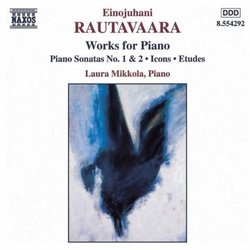| All Artists: Einojuhani Rautavaara, Laura Mikkola Title: Einojuhani Rautavaara: Works for Piano Members Wishing: 2 Total Copies: 0 Label: Naxos Release Date: 7/20/1999 Genre: Classical Styles: Chamber Music, Forms & Genres, Etudes, Sonatas, Suites, Historical Periods, Classical (c.1770-1830), Modern, 20th, & 21st Century Number of Discs: 1 SwapaCD Credits: 1 UPC: 636943429228 |
Search - Einojuhani Rautavaara, Laura Mikkola :: Einojuhani Rautavaara: Works for Piano
 | Einojuhani Rautavaara, Laura Mikkola Einojuhani Rautavaara: Works for Piano Genre: Classical
|
Larger Image |
CD DetailsSimilarly Requested CDs |
CD ReviewsOne of the best etudes ever composed SRS | Ohio | 08/03/2006 (5 out of 5 stars) "This is 20th century music, so "Mozart or nothing" fans need not apply. Rautavaara's typical piano style consists of two basic forms: dazzlingly dense and sparse/muted. Both occur in his large pieces. Tveitt, in his later piano concertos, is somewhat similar to Rautavaara in his concertos. Fans of one should check out the other.
The "Thirds" etude alone is worth the price of the disc. It is one of the best pieces of music I've heard. If I were a pianist, it would be part of my debut recital programme. The rest of the etudes are good, particularly the fast ones, but not absolutely perfect like the first one. "Icons" is a scintillating collection that is reminiscent of Satie, albeit with many more notes in fast sections and a greater emphasis on chromaticism. Rautavaara's musical language on this disc is apparent in his piano concertos. The often harsh Preludes are reminiscent of early Ornstein. As with the Etudes, the pieces are arranged so that an energetic, even frenetic, piece is followed by a slow and sparse piece. Partita is a bit reminiscent of Allen Sapp, particularly in the third movement. The first Sonata has a very unusual structure. It's opening movement could be mistaken for a central movement and vice-versa, although the final quarter of the movement has a dense progression of notes like the 2nd concerto or some of the faster etudes. The second movement opens in a rapid expository fashion that one would expect from a first movement and abruptly becomes spare and spacious, space that continues into the brooding third movement, which closes with a bell-like motif. This sonata is very unique among those I've heard, being difficult to recognize as a sonata. I don't yet consider it a strong piece; perhaps further listening will change my mind. The second sonata is absolutely different. It opens with typical sonata expository "pull", albeit with Rautavaarian flurry-of-notes language that you'll find in the concertos. This opening transitions to a lovely and very simple progression of chord, which go from heavenly to dour. The second movement is more abtract, with rather sparse and dour chords in the first third, climaxing with two brilliant "white noise" chords that consist of every note vertically and horizontally in a large space between hit simultaneously, and the flurry-of-notes structure. A somewhat macabre dance comes later, reminiscent of Ornstein and perhaps Stravinsky, while being still thoroughly Rautavaarian. The first movement's chordal progression returns, but it is changed, being more ethereal, as if the notes are moving into plasma (or flame). The second sonata is more accessible, despite its harder edge, because it contains more emotive material than the first. The ending may be a bit anticlimactic, however, since the chordal progression in the first movement and the climax in the middle of the second movement are perhaps more effective, but the ending is rather haunting. Perhaps if the chords were given more space in performance it would be even better..." |

 Track Listings (28) - Disc #1
Track Listings (28) - Disc #1


